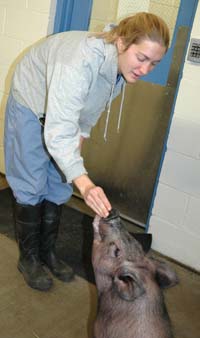 |
|
 |
Up on the Farm
Exploring the NIH Animal Center, Our Second Campus |
| By Sarah Schmelling |
| |
 |
 |
 |
| |
Contractor Blair Casey feeds a pig on the farm. |
You’ve been to Executive Plaza. You know about NIEHS in North Carolina, about NIH buildings in Baltimore and Frederick, even some structures within the broad category
of “Washington Metropolitan Area Leased Facilities.” What you may not know is that about 30 miles northwest of the main campus, on a 509-acre stretch of rolling farmland,
lies the NIH Animal Center at Poolesville.
It’s one of NIH’s “best-kept secrets,” says Dr. Douglas Powell, chief of the Poolesville veterinary medicine section.
One can see why the NIHAC, known as “the farm,” is not so well-known. On a mid-winter morning, it’s a long drive on winding, frosty country roads to reach the center
at a distant edge of Montgomery County. And though it’s just a few miles from the Potomac River and not even far, Powell says, from Dulles International Airport, it’s a quiet location.
more…
|
|
|
Bridging the Licensing Gap
New Site Eases Industry Search for Rare Disease Technologies |
| By Sarah Schmelling |
|
Science meet Industry, Industry meet Science. This pairing—of NIH- and FDA-developed technologies and the companies interested in licensing them—would seem to be a perfect match. But it’s always been difficult for companies,
from small biotech firms to large pharmaceutical
companies, to search among the myriad technologies available for licensing to find one they could potentially use to create a new product.
This is why NIH’s Office of Technology Transfer
(OTT) recently came up with the idea of creating web sites that list all available technologies
in specific medical areas. That way, companies can visit one site, see all technologies
ready to be licensed and perhaps find one they can develop into a product that assists in diagnosis, treatment or prevention of a disease.
OTT started last year with a web module focused on neglected diseases and, in January, launched a much larger site in conjunction with the Office of Rare Diseases (ORD) with support from the National Human Genome Research Institute.
more…
|
|
|
|
|
 |

